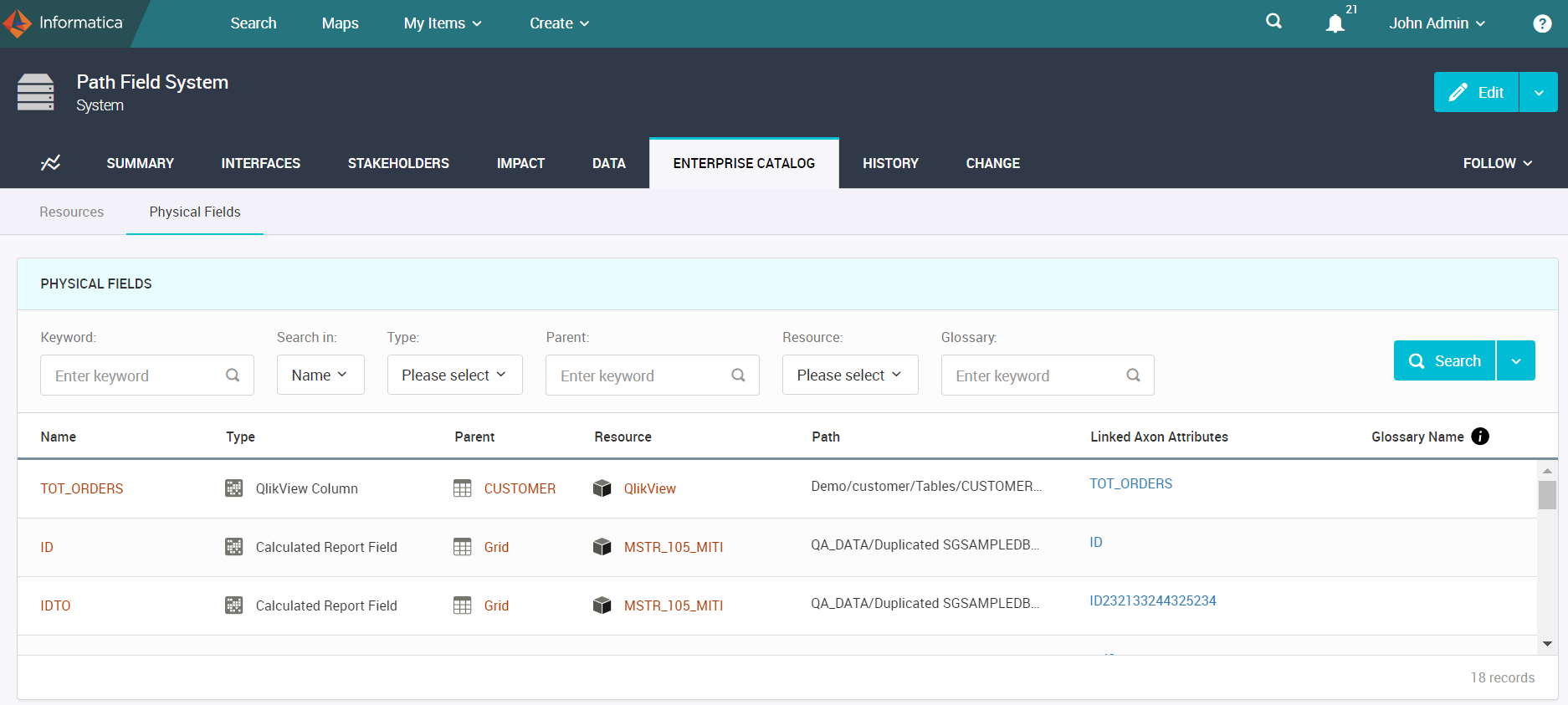View Enterprise Catalog in System
After you install and configure Enterprise Data Catalog, you can view the Resources and Physical Fields sub-tabs under the Enterprise Catalog tab of a System object.
To view resources in the
Resources sub-tab of a System object, you need to link the system to a resource. From the Axon toolbar, click
Create >
Manage Catalog Links and create a resource to system link from the
Resources facet. For more information, refer to
Linking Resources with Systems Manually.
After you link a system to a resource, you need to link the physical fields to attributes to view field information in the Physical Fields sub-tab of the System object.
In the Edit mode of a System object, you can perform the following operations in the Enterprise Catalog > Physical Fields tab:
In the View mode of a System object, you can see the resources and physical fields that are associated only to the System object. In the Edit mode of a System object, you can link physical fields to existing attributes or create attributes from the data sets within the system. The Resources tab does not appear in the Edit mode of a System object.
The following image shows the Enterprise Catalog > Physical Fields view of a System object:
You can filter the information in the Physical Fields tab by status type. You can search by the field name, parent name, glossary, and narrow down the search by selecting resources to search in. In the Parent Name field, Axon displays suggestions for table names along with the schema information for relational sources and path information for non-relational sources.
Export Physical Fields
You can export the physical fields metadata to a CSV file. You can export the physical fields from Axon in View and Edit modes of the System object. In the search area of the
Physical Fields tab, click the

icon next to the
Search option and click
Export to CSV. The name of the exported file is in the following format:
Physical Fields-<YYYYMMDD>.csv. Make sure that the CSV file viewer displays characters that are encoded in UTF-8 format.
You can view the following metadata in the exported CSV file:
- Physical Field Name
- Name of the physical field.
- Parent
- Parent of the physical field. You can see the table names along with the schema information for relational sources and path information for non-relational sources.
- Resource Name
- Name of resource that contains the physical field.
- Physical Field ID
- Identifier for the physical field.
- Path
- Location of the physical field.
- Class Type
- Object class type of the physical field.
- Glossary Name
- The Axon glossary that the physical field is linked to. The exported file contains all the associated, inferred, and accepted glossaries.
You can export up to 5000 physical fields. If the number of physical fields are more than 5000, you can apply filters and then export.
You can also export the physical fields metadata from the
Physical Fields tab in the
Create >
Manage Catalog Links page. For more information, see
Enterprise Data Catalog Objects.


 icon next to the Search option and click Export to CSV. The name of the exported file is in the following format: Physical Fields-<YYYYMMDD>.csv. Make sure that the CSV file viewer displays characters that are encoded in UTF-8 format.
icon next to the Search option and click Export to CSV. The name of the exported file is in the following format: Physical Fields-<YYYYMMDD>.csv. Make sure that the CSV file viewer displays characters that are encoded in UTF-8 format.